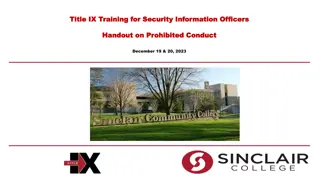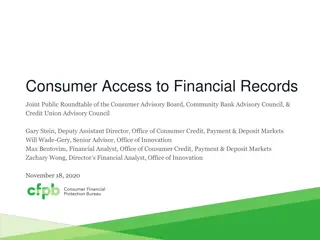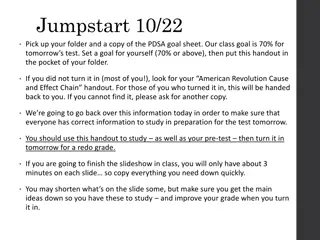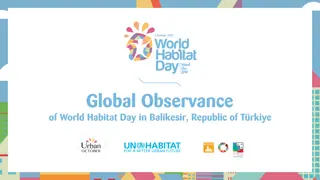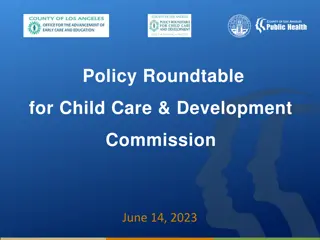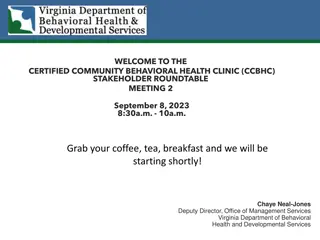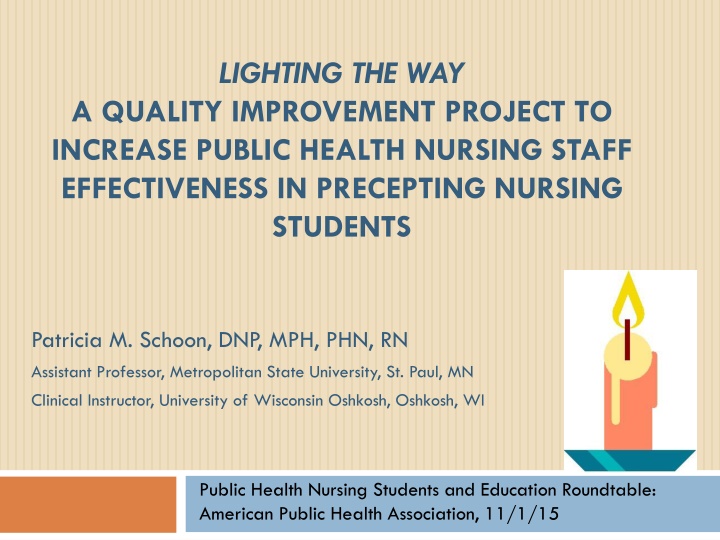
Enhancing Public Health Nursing Precepting Effectiveness
Learn about a quality improvement project aiming to increase public health nursing staff effectiveness in precepting nursing students. Explore the objectives, background, and the importance of preceptorship in nursing education.
Download Presentation

Please find below an Image/Link to download the presentation.
The content on the website is provided AS IS for your information and personal use only. It may not be sold, licensed, or shared on other websites without obtaining consent from the author. If you encounter any issues during the download, it is possible that the publisher has removed the file from their server.
You are allowed to download the files provided on this website for personal or commercial use, subject to the condition that they are used lawfully. All files are the property of their respective owners.
The content on the website is provided AS IS for your information and personal use only. It may not be sold, licensed, or shared on other websites without obtaining consent from the author.
E N D
Presentation Transcript
LIGHTING THE WAY A QUALITY IMPROVEMENT PROJECT TO INCREASE PUBLIC HEALTH NURSING STAFF EFFECTIVENESS IN PRECEPTING NURSING STUDENTS Patricia M. Schoon, DNP, MPH, PHN, RN Assistant Professor, Metropolitan State University, St. Paul, MN Clinical Instructor, University of Wisconsin Oshkosh, Oshkosh, WI Public Health Nursing Students and Education Roundtable: American Public Health Association, 11/1/15
Co-Authors 2 Bonnie Brueshoff, DNP, RN, PHN Public Health Director Community Partner for DNP Project Dakota County Public Health Nursing Lead Team Gina Adasiewicz, MS, PHN, Supervisor Carol Messler, BSN, PHN, Supervisor Amy Mimm, MS, PHN, Supervisor Coral Ripplinger, MS, PHN, Program Coordinator, Supervisor
Acknowledgements 3 Dakota County Public Health Nurses (Family Health and DPC/EP Teams) Teddie Potter, PhD, MS, RN Clinical Associate Professor, School of Nursing, University of Minnesota Advisor for DNP Project Linda Olson Keller, DNP, RN Clinical Professor, School of Nursing, University of Minnesota Former Director, Public Health Nursing, Minnesota Department of Health
OBJECTIVES 4 Identify the quality improvement gaps or barriers to effective PHN precepting of baccalaureate nursing students in a community setting. Design a preceptor staff development program for PHN staff employing both online and face-to-face modules. Describe the benefits of a dual-intervention QI approach of staff development and organizational consultation to create sustainable organizational change.
Background 5 1949 National Organization for Public Health Nursing identified responsibility for public health nursing to participate in education of nursing students as one of its core functions. Adams, 2004 21st Century Need for more baccalaureate nurses prepared for public health nursing Fewer public health nurses available for precepting Not all PHNs prepared for population-based practice Gebbie & Hwang, 2000; Keller, Schaffer, Schoon, Brueshoff & Jost., 2011; Lee & Greenwald, 2009; Moon, Henry, Connelly, & Kirsch, 2005 Clinical experience in public health agency only clinical setting related to increased student interest in becoming a public health nurse Zahner, 2013 PHN Workforce is aging 36% at least 56 years of age PHN Workforce Study (University of Michigan, 2013)
What is a Preceptor? 6 Preceptor Definition Preceptorship Experience An experienced nursing professional who teaches, supervises, and serves as a role model for a student or graduate nurse for a pre- arranged time in a formalized program. Experience is defined as involving an experienced nurse and a novice, either a student or a new hire, working together in a formal relationship for a specific period of time to assist the novice in successfully adjusting to and meeting the expectations of the new role. Canadian Nurses Association, 1995). Usher, Nolan, Reser, Owens, & Tollefson as cited in Biggs & Schriner, 2010, p. 319.
Engagement of The Preceptor Triad 7 Precepting consists of a preceptorship triad an equal relationship between the nurse preceptor, faculty instructor, and student and also identified four domains of preceptor practice: Artfully connecting Creating a culture of respect Acknowledging contextual realities Preserving the ideals of ethical, competent, and respectful care Patton, 2010, pp. 143-145 Preceptor Student Faculty
Precepting as a Bridge Application of Theory to Practice 8 The nurse preceptor is an essential bridge between the classroom and the real world of human patients and clinical settings. Raines, 2012, p. 76
Key Preceptor Roles 9 Role Model Unique PHN practice Authentic self Personal stories Guide Navigating the experience Coaching, supporting, and directing Teacher Appling theory Evidence-based practice Skill development
Preceptor Practice and Staff Development Literature 10 Preceptor Needs Preceptor Staff Development Most studies are hospital-based. Focus is on preceptor skill building. Content update needed in PHN. Most preceptors do not have formal preparation but want it. Face-to-face, online, self-directed study all have been successful. Common barriers include time commitment, fitting precepting into daily work, lack of recognition, support, and preparation. Follow-up with management recognition & support is necessary. Peer consultation & support is important. Preceptor self-efficacy and satisfaction higher when formal training precedes precepting experiences. Identified need for faculty to be involved in preceptor preparation and preceptor-student activities.
Barriers to Precepting 11 Midwestern Public Health Nursing Agency Long-term partnerships with Minnesota Schools of Nursing Provides clinical experiences for baccalaureate nursing students Experienced PHN staff Quality improvement gap in effective precepting
Partnership Barriers 12 The complexity of collaboration with nursing programs and faculty in providing clinical learning experiences for students due to: Working with multiple diverse nursing programs within each calendar year Lack of knowledge of individual nursing program curriculums and where the community health course occurs in each of the program curriculums Lack of knowledge of the community health course sequence in the curriculum, clinical objectives, and expected student outcomes Lack of student preparation and sometimes interest in the clinical experience Conflicts between nursing program, students, and public health nursing preceptors schedules and available time
Agency Barriers 13 Availability and ability to provide precepting experiences for students due to: Time and staff availability limitations Difficulty integrating student precepting experiences into PHN workday Lack of clinical tools for teaching-learning Lack of Preceptor Preparation A sense of powerlessness among preceptors
PHN Staff Preceptor Needs 14 A need for preceptor staff development and continuing education due to: Inadequate precepting skill development for PHNs who precept nursing students Lack of knowledge of current expected entry-level competencies of BSN graduates Need for preceptors to receive an update on the knowledge and competencies for population-based practice
Precepting Experience 15 Q 31 Precepted Nursing Students Before Q 32 Participated in Preceptor Training Before 5 (19%) 9 (32%) Yes No Yes No 19 (68%) 22 (81%) N = 27 of 28 N = 28 of 28
QI PROJECT: Lighting the Way 16 Quality Improvement Issue Precepting nursing students had many barriers that resulted in less effective and efficient PHN precepting practice than desired. Goal Increase the number of staff public health nurses who were confident that they were able to efficiently and effectively integrate precepting into their daily work. QI Intervention Plan PHN Preceptor Staff Development Program Organizational Consultation
QI Dual Intervention Approach 17 Public Health Agency Director and Nurse Educator Initiative (HSC Partners) Public Health Director Preceptor Staff Development Program Blended face-to-face and online tutorials Supervisors, Program Coordinator Lead Team Organizational Consultation Collaboration Communication Three Levels of Organization 3 PHN Teams PHN Staff
Building on Strengths 18 Learning organization with ongoing commitment to staff development and staff empowerment Strong history of organization EBP and commitment to QI Ongoing commitment to work in partnership with local Schools of Nursing to prepare PHNs for future Administration willing to make changes based on staff recommendations Management (supervisors) strong advocacy for PHN staff Majority of PHN staff motivated to precept nursing students
Self-Efficacy Framework Learner Needs, Curriculum Development, Evaluation 19 Self-Efficacy Theory and Teaching Self-Efficacy Theory Self-efficacy as a judgment about one s ability to carry out specific activities successfully Bandura, 1982 Midrange Theory Sense of Self-efficacy belief that one can influence student behaviors and outcomes Significant research Beliefs of Self-efficacy the belief that one can perform certain tasks successfully within a certain context Little research Dellinger, et al., 2008 Based on Social Learning Theory Bandura, 1977
Framework: Social Cognitive Learning and Self-Efficacy Theories 20
Needs Assessment Overall Interest Level 21 427 450 N = 27 RR = 90% 400 350 Aggregate results of all questions 300 221 220 250 200 70% Items Agree/Strongly Agree 150 50 100 50 Mean = 2.9 0 1 2 3 4
Priority Target Ranking Top Two of Seven 22 Target 1 (85-96% Agree) Q4 Evidence-based public health nursing practice Q18 Demonstrating leadership in working with clients and PHN staff Q25 Integrating precepting activities into daily work Q26 PHN Interventions Student Self- Audit Tool Q28 PHN Scope of Practice Observation/Shadowing Tool Q32What Makes a Good Home Visit/Client Audit Tool Target 2 (78 81% Agree) Q 3 Entry-level public health nursing competencies Q7 Applying public health nursing process to communities Q21 Communication and feedback Q 22 Teaching-learning strategies Q23 Role modeling public health nursing Q27 PHN Population-Based Competency Self-Audit Tool Q31 Learner Readiness/Teaching Plan Tool Q33 Using PHN Process Self-Audit Tool
Lighting the Way Curriculum 23 Module 1: Precepting Nursing Students and Role Modeling Public Health Nursing Module 3: Teaching/Learning Strategies for Working with Students and Clients Module 2: Public Health Nursing Process and Public Health Nursing Interventions Module 4: Community Needs, Public Health Nursing Ethics and Leadership Module Format: 6 8 Online tutorials followed by face-to-face sessions
Project Deliverables 24 Preceptor Staff Development curriculum (4 blended modules with online tutorials and face-to-face sessions for each) Continuing education eligible units (CEUs) certificate Resource binders for each participant One copy per team of text, Population-Based Public Health Clinical Menu The Henry Street Model for Nurses (2nd ed.) by Garcia, Schaffer, & Schoon (2014) Ongoing access to online presentations through author s Voicethread account
Project Evaluation Outcome One Demonstrate a 20% increase in confidence to precept nursing students. 25 Outcome 1: Likert Scale Frequency for Q1 through Q25 1.0 Pre-Test Post-Test 0.8 Category 2 56.9% 86.4% = 29.5% 0.6 Frequency 0.4 0.2 0.0 1 2 3 4 Likert Scale Means Pre-test 2.65 Posttest 3.25 Difference .60
Demonstrate a 20% increase in confidence in their ability to help students understand public health nursing practice. Outcome Two 26 Outcome 2: Likert Scale Frequency for Q1 through Q6 1.0 Pre-Test Post-Test 0.8 0.6 Frequency Category 2 0.4 63.1% 0.2 95.9% = 32.8% 0.0 1 2 3 4 Likert Scale Means Pre-test 2.77 Posttest 3.45 Difference .68
Demonstrate a 20% increase in confidence in their ability to help students develop entry-level public health nursing competencies. Outcome Three 27 Outcome 3: Likert Scale Frequency for Q7 through Q16 1.0 Pre-Test Post-Test 0.8 0.6 Category 2 62.7% Frequency 0.4 88.0% = 0.2 25.3% 0.0 1 2 3 4 Likert Scale Means Pre-test 2.78 Posttest 3.31 Difference .53
Demonstrate a 20% increase in confidence in their ability to use clinical teaching-learning strategies to assist nursing students practice public health nursing. Category 2: 46.1% 78.3% = 32.2% Outcome Four 28 Outcome 4: Likert Scale Frequency for Q17 through Q25 1.0 Pre-Test Post-Test 0.8 0.6 Frequency 0.4 0.2 0.0 1 2 3 4 Likert Scale Means Pre-test 2.44 Posttest 3.04 Difference .60
Demonstrate a 20% increase in confidence that they can integrate the demands of precepting nursing students effectively and efficiently into their daily workload. Outcome Five 29 Q25: I can integrate the demands of precepting nursing students effectively and efficiently into my daily workload 1.0 Pre-Test Post-Test 0.8 0.6 Category 2: Frequency 46.0% 0.4 65.0% = 0.2 19.9% 0.0 1 2 3 4 Likert Scale Means Pre-test 2.36 Posttest 2.75 Difference .39
Identify specific knowledge, skills, and tools obtained or developed from the Preceptor Staff Development Program that they are likely to use to increase their effectiveness in integrating precepting responsibilities and activities into normal workday. Outcome Six 30 Knowledge Updates and Resources Application to practice Skills & Strategies Student- Preceptor Communication Role Modeling Assessing Student Learning Styles Tools Shadowing Student Self-Audit
I feel more positive about precepting students now than I did before participating in Lighting the Way. 31 More Positive About Precepting 90 15 (79%) 80 RR = 19 of 20 (95%) 70 60 50 40 30 3 (15%) 20 1 (5%) 10 0 Strongly Disagree Disagree Agree Strongly Agree
Lighting the Way met my learning needs for more effectively precepting nursing students 32 Met Learning Needs 80 12 (67%) 70 N = 18 of 20 (90%) 60 50 40 5 (27%) 30 20 1 (5%) 10 0 Strongly Disagree Disagree Agree Strongly Agree
PHN Staff Recommendations 33 Organizational Changes from top down all three levels Both in structure and processes of student clinical experiences Faculty Engagement Preceptor-clinical faculty Schools of Nursing and PH Agency partnership Student preparation for clinical Integrate Lighting the Way content Structure and processes of organization at all three levels Ongoing PHN discussions of how putting content into practice with students Preceptor-Student activities Interactions with clinical faculty
Dual Intervention Approach 34 Creating sustainable organizational change through: Staff development Organizational consultation
Benefits of Dual-Intervention Approach 35 Staff development paired with organizational consultation facilitates Collaboration with Lead Team Flexibility in plan and implementation Opportunity for peer consultation and support Follow-up with management Administrative recognition & support Facilitates engagement and empower staff Increases ownerships and commitment Faculty and PH Agency staff working in partnership provide best outcomes for preceptor staff development. Staff provides real life creative ideas
Facilitates Ongoing Engagement and Commitment 36 Faculty and Preceptor Preceptor and Student Agency Nursing Program Arrangements Shared Knowledge Role Preparation & Expertise Communication Collaboration Flexibility Accountability Preceptor Availability Student Preparation Communication Flexibility Clinical Teaching/Learning Tools Student Accountability



